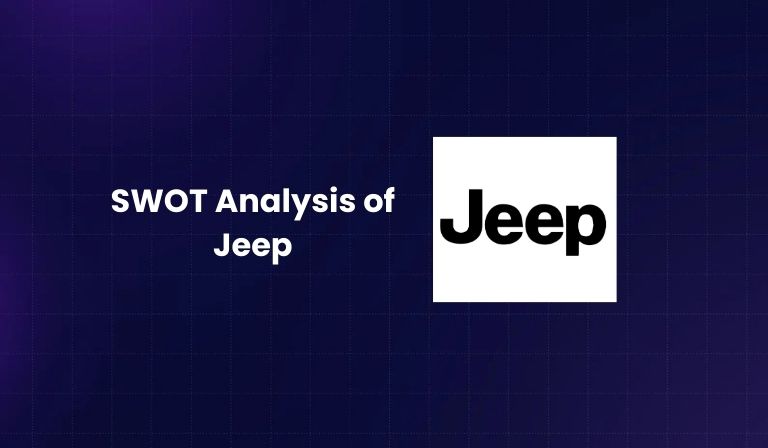Summary
The SWOT Analysis of Jeep provides a clear picture of how this iconic American automobile brand stands in today’s competitive market. Jeep’s strengths lie in its rugged image, legendary design, and unmatched off-road performance. Its weaknesses include high pricing, repetitive design language, and low international penetration. On the other hand, Jeep has several opportunities—expansion into emerging markets, targeting millennials, and leveraging technology to innovate. However, threats such as electric vehicle adoption, rising fuel costs, and stricter environmental regulations pose challenges to its future growth. This blog explores Jeep’s position in 2025 in detail and answers key questions about its future outlook.
Jeep is one of the most recognizable automobile brands in the world. Born out of military heritage during World War II, Jeep evolved into a symbol of freedom, adventure, and ruggedness. Today, Jeep is a division of FCA US LLC, a wholly owned subsidiary of Fiat Chrysler Automobiles (now Stellantis). Its headquarters are located in Toledo, Ohio, a city historically tied to Jeep’s manufacturing roots.
The Jeep brand became part of Chrysler in 1987 when it acquired American Motors Corporation (AMC). Since then, Jeep has built a loyal customer base and maintained its position as a leader in off-road and SUV segments.
This blog dives deep into the SWOT Analysis of Jeep, examining its strengths, weaknesses, opportunities, and threats to understand where it stands in the global automotive industry in 2025.
Strengths of Jeep
1. Strong Brand Image and Reputation
One of Jeep’s biggest strengths is its powerful brand equity. Jeep is more than just a car—it is a lifestyle choice. The word “Jeep” has become synonymous with ruggedness and adventure. Its reputation for durability and reliability has been built over decades, starting with its military vehicles.
Customers who buy Jeep vehicles are often strong advocates of the brand. The positive word-of-mouth marketing generated by loyal Jeep enthusiasts enhances its credibility and attracts new customers.
2. Iconic Design
Jeep’s design is legendary. The seven-slot grille, boxy shape, and rugged stance make it one of the most recognizable vehicle designs in the world. Models like the Wrangler and Cherokee have retained their signature look for decades, reinforcing Jeep’s identity.
While other carmakers frequently revamp their vehicles to follow design trends, Jeep’s consistency in design has worked to its advantage. It conveys reliability, timelessness, and brand confidence—making Jeep vehicles instantly stand out on the road.
3. Excellent Towing and Off-Road Capabilities
Jeep has set the benchmark in off-road and towing performance. With features like 4×4 systems, all-wheel drive (AWD), and advanced suspension technology, Jeep has carved a niche in the adventure and SUV segment.
This capability is not just marketing—it is Jeep’s DNA. Whether it’s traversing mountains, deserts, or forests, Jeep vehicles are trusted companions for explorers and outdoor enthusiasts. Its strong performance in the SUV and crossover category positions Jeep as a market leader.
4. Adventurous Brand Identity
The Jeep brand naturally aligns with themes of freedom, exploration, and adventure. The very name “Jeep” is associated with rugged terrains and outdoor lifestyles. This positioning makes Jeep highly attractive to customers who value experiences, outdoor activities, and adventure-based lifestyles.
Marketing campaigns often highlight Jeep owners driving through rivers, climbing rocky terrains, or exploring wilderness—all of which reinforce its adventurous identity.
Weaknesses of Jeep
1. High Pricing
One of the key weaknesses revealed in the SWOT Analysis of Jeep is its premium pricing strategy. Jeep vehicles are more expensive than many competitors in the SUV category. While brand enthusiasts are willing to pay, the higher prices limit Jeep’s appeal to middle-class families in price-sensitive markets like Asia and Latin America.
This restricts Jeep’s ability to expand aggressively and compete against more affordable alternatives like Toyota, Hyundai, or Ford SUVs.
2. Repetitive Design Language
While the iconic design is a strength, it also turns into a weakness. For decades, Jeep has maintained a very similar look across models. While loyalists love this consistency, younger buyers sometimes perceive it as lack of innovation.
In a market where aesthetics and modern appeal drive buying decisions, Jeep risks losing younger consumers to competitors that regularly refresh designs with futuristic elements.
3. Low Global Penetration
Jeep has a strong presence in the U.S. market, but its global footprint is relatively weak. In countries like India, China, and Southeast Asia, Jeep has not been able to establish a strong base due to high pricing, limited dealerships, and lack of localized models.
This low global penetration restricts Jeep from realizing its full potential as a truly international brand.
Opportunities for Jeep
1. Expanding into Growing Markets
Emerging economies like India, Brazil, and Southeast Asia are witnessing rising incomes and increasing demand for SUVs. Jeep can launch slightly lower-priced models to penetrate these markets.
By tailoring vehicles to regional needs and price sensitivities, Jeep can expand its customer base and establish itself as a global SUV leader.
2. Targeting Millennials
Millennials and Gen Z customers are more adventurous and lifestyle-driven compared to previous generations. They value outdoor travel, road trips, and unique experiences—all of which align perfectly with Jeep’s identity.
By designing youth-oriented marketing campaigns and introducing models that cater to urban lifestyles, Jeep can capture this influential demographic and ensure long-term growth.
3. Rising Health-Conscious and Adventure-Oriented Consumers
The growing trend of health and fitness has boosted interest in activities like hiking, camping, and road trips. Jeep, already positioned as an adventurous brand, can capitalize on this by targeting this customer segment with relevant campaigns and collaborations (for example, partnering with adventure tourism brands).
4. Innovation through Technology
Jeep is still heavily dependent on its traditional design and mechanical appeal. However, the modern automobile market demands innovation in connectivity, safety, and electrification.
By investing in electric SUVs, hybrid technology, and smart connected features, Jeep can stay competitive and attract tech-savvy buyers. Collaborations with technology firms could also accelerate this transition.
Threats to Jeep
1. Rise of Electric Vehicles (EVs)
The EV revolution is one of the biggest threats to Jeep. With brands like Tesla, Rivian, and even traditional automakers like Ford and GM entering the EV space, Jeep risks being left behind if it doesn’t innovate quickly.
As governments worldwide push for electrification, Jeep will need to develop electric off-road SUVs to remain relevant in the long term.
2. Increasing Fuel Prices
Jeep’s vehicles are fuel-hungry SUVs. Rising fuel prices make them expensive to own and operate, pushing consumers toward more economical vehicles or EV alternatives. This could significantly impact Jeep’s sales, especially in cost-sensitive regions.
3. Environmental Regulations and Pollution Concerns
Governments across the globe are imposing stricter regulations on emissions and fuel efficiency. Jeep, known for its larger SUVs, faces challenges in adapting to these rules. Failure to comply could mean restrictions on sales in key markets or higher costs due to technology upgrades.
Conclusion
The SWOT Analysis of Jeep highlights a brand with a strong legacy and a powerful market identity. Jeep’s strengths in brand equity, design, and off-road capabilities have created a loyal customer base and a niche positioning. However, weaknesses such as high pricing, limited innovation in design, and weak global penetration prevent it from scaling further.
Jeep’s opportunities lie in expanding into emerging markets, targeting millennials, and innovating with new technologies like EVs and connectivity. But the threats from EV disruption, fuel prices, and environmental regulations require Jeep to act decisively.
If Jeep successfully evolves with market demands while retaining its adventurous DNA, it can continue to thrive as a leader in the global SUV market.
FAQs
What is Jeep best known for?
Jeep is best known for its rugged SUVs and legendary off-road capabilities. Its vehicles like the Wrangler are icons in the SUV segment.
What are the main weaknesses of Jeep?
High pricing, repetitive design, and low global penetration are Jeep’s primary weaknesses.
Does Jeep have opportunities for growth?
Yes. Jeep has significant growth opportunities in emerging markets, EV innovation, and targeting younger, adventure-oriented consumers.
Who are Jeep’s main competitors?
Jeep competes with brands like Toyota, Ford, Land Rover, Hyundai, and Kia in the SUV and off-road vehicle segment.
What threats does Jeep face in 2025?
The rise of electric vehicles, increasing fuel prices, and stricter environmental regulations are the biggest threats to Jeep’s business model.
A digital marketer with a strong focus on SEO, content creation, and AI tools. Creates helpful, easy-to-understand content that connects with readers and ranks well on search engines. Loves using smart tools to save time, improve content quality, and grow online reach.

